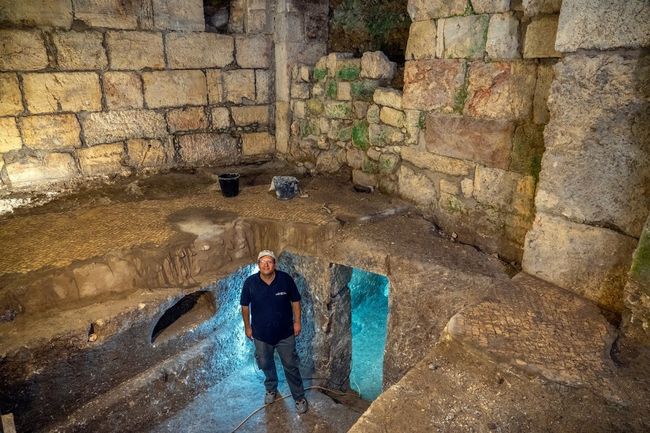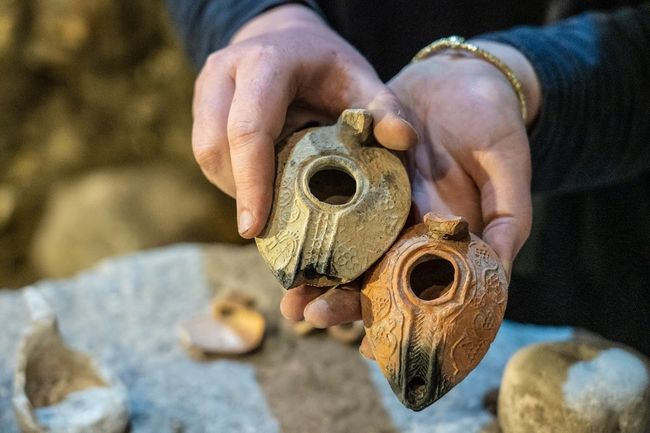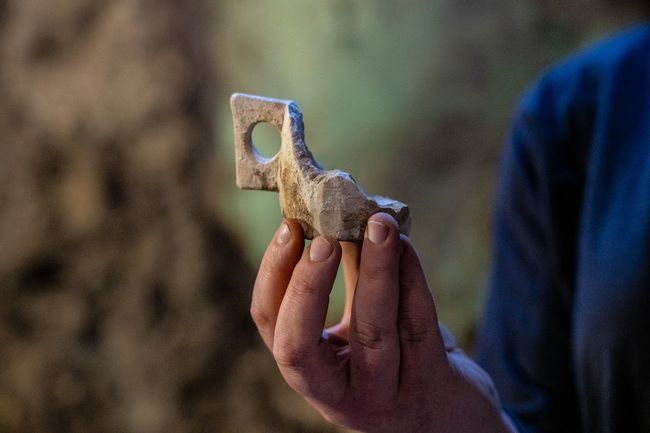Skip to comments.
Hidden underground chambers unearthed near Israel's Western Wall
Live Science ^
| 5-18-20
| Yasemin Saplakoglu
Posted on 05/24/2020 12:46:06 PM PDT by SJackson
It's not clear why ancient people dug up these chambers, but evidence suggests they used them in everyday life.

Co-director of the excavation Barak Monnickendam-Givon standing in the subterranean chambers. (Image: © Yaniv Berman-Israwl Antiquities Authority) Archaeologists recently uncovered three ancient subterranean chambers carved in the bedrock beneath the Western Wall plaza in Jerusalem.
The 2,000-year-old chambers, consisting of an open courtyard and two rooms, were carved on top of one another and connected by hewn staircases. Inside the chambers, archaeologists discovered clay cooking vessels, cores of oil lamps, a stone mug and a piece of a qalal, or a large stone basin that was used to hold water for rituals, according to a statement from the Israel Antiquities Authority.
At the entrance to the chambers, the archeologists also found a long carving for shelves and depressions for door hinges and bolts, as well as round, square and triangular niches carved into the walls, some of which could have been used to place oil-lamps in.
These findings likely mean that these chambers were used daily, according to the statement. But it's not clear what they were actually used for. "Perhaps, it served as a pantry for an overhead structure that didn't survive, or as a hewn space" for living underground, Mordechai Eliav, the director of the Western Wall Heritage Foundation, said in the statement.

Oil candles were among the items discovered in the underground chambers.Oil candles were among the items discovered in the underground chambers. (Image credit: Yaniv Berman, Israel Antiquities Authority)
"We're asking ourselves what was the function of this very complex rock-cut system?" co-director of the excavation Barak Monnickendam-Givon said in an accompanying video. People could have lived in these underground chambers or stored food or groceries there for possibly another long-gone building above it. "Another possibility is that this system was used for hiding during the siege on Jerusalem 2000 years ago when the roman legions conquered the city," he said.
The subterranean chambers were hidden beneath the white mosaic floor of a public building that was created around 1,400 years ago during the Byzantine period. The building was renovated about 1,250 years ago, during the Abbasid period, according to the statement. In the 11th century, the building was destroyed and the subterranean chambers, along with other finds, were buried and stayed hidden for centuries.
These chambers were found in the "Beit Strauss" complex, beneath the entrance lobby to the Western Wall Tunnels, which helped the builders of the wall support its massive weight. (The tunnels also contained channels that supplied water to the Second Temple, according to Atlas Obscura).

Archeologists discovered this measuring cup in the chambers.Archeologists discovered this measuring cup in the chambers. (Image credit: Yaniv Berman, Israel Antiquities Authority)
The complex was likely used by residents of the city during the early Roman period, before Jerusalem was destroyed in A.D. 70, according to a statement from the Israel Antiquities Authority. The Western Wall is the only remaining part of the Second Temple of Jerusalem, which the Romans destroyed along with the rest of the city, according to the Encyclopedia Britannica.
The discovery was made by students in Jerusalem.
TOPICS: Israel; News/Current Events
KEYWORDS: ancientisrael; archeology; chambers; godsgravesglyphs; herodthegreat; israel; jerusalem; letshavejerusalem; romanempire; underground; wailingwall; westernwall
1
posted on
05/24/2020 12:46:06 PM PDT
by
SJackson
To: SJackson
Pretty cool and thanks for posting. Archeology is something that always captures my imagination!
2
posted on
05/24/2020 12:50:25 PM PDT
by
volunbeer
(Find the truth and accept it - anything else is delusional)
To: SunkenCiv; dennisw; Cachelot; Nix 2; veronica; Catspaw; knighthawk; Alouette; Optimist; weikel; ...
Middle East and terrorism, occasional political and Jewish issues Ping List. High Volume If you’d like to be on or off, please FR mail me.
..................
Thanks to SunkenCiv
3
posted on
05/24/2020 12:51:52 PM PDT
by
SJackson
(Suppose you were an idiot, suppose you were a member of Congress; but I repeat myself, Mark Twain)
To: SJackson
Did they have Mexican cartels back then?
4
posted on
05/24/2020 12:53:06 PM PDT
by
dp0622
(Radicals N racists dont point ftingers at me I'm a small town white boy Just tryin to make ends meet)
To: SJackson
To: SJackson
This is news? Underground tunnels, pools and chambers all over the Temple campus were discovered long ago.
6
posted on
05/24/2020 12:55:34 PM PDT
by
Eleutheria5
("SHUT UP!" he explained.)
To: SunkenCiv; SJackson
7
posted on
05/24/2020 1:51:29 PM PDT
by
TXnMA
(Anagram: "PANDEMIC --> DEM PANIC"<P>)
To: SJackson
I often wonder if this stuff is filled in, or just ignored so long it fills up?
To: SJackson
Just from the photo -- taken at that angle, I would not have ID'd the object in that third photo as a "measuring cup"...
TXnMA
9
posted on
05/24/2020 1:54:40 PM PDT
by
TXnMA
(Anagram: "PANDEMIC --> DEM PANIC"<P>)
To: StayAt HomeMother; Ernest_at_the_Beach; 1ofmanyfree; 21twelve; 24Karet; 2ndDivisionVet; 31R1O; ...
Thanks SJackson! The non-archaeological angle here is, SunkenCiv is a little lazy. And thanks Phinneous for the other article link that contained this link. :^) I will get that one posted in a moment, I was about three days behind some other stuff.

10
posted on
05/24/2020 2:55:12 PM PDT
by
SunkenCiv
(Imagine an imaginary menagerie manager imagining managing an imaginary menagerie.)
To: dp0622
“Did they have Mexican cartels back then?”
Nah bro.
Man caves!
The priests and temple attendants needed a place they could hang out, fart and scratch themselves in peace. Maybe tipple little sacramental wine as well.
Dudes needed some privacy.
11
posted on
05/24/2020 3:06:15 PM PDT
by
oldvirginian
(The average "progressive" makes Jethro Bodean look like Albert Einstein)
To: oldvirginian
12
posted on
05/24/2020 3:13:19 PM PDT
by
MHGinTN
(A dispensation perspective is a powerful tool for discernment)
To: TXnMA
13
posted on
05/24/2020 3:20:03 PM PDT
by
SunkenCiv
(Imagine an imaginary menagerie manager imagining managing an imaginary menagerie.)
To: SunkenCiv
I have one of those oil lamps (not from the dig, of course) as a reminder to keep my lamp filled.
Thanks for the ping!
:o]
‘Face
14
posted on
05/25/2020 4:07:19 AM PDT
by
Monkey Face
(In case no one else is telling you, the world will not be better without you. ~ Al Carroway ~)
To: SJackson
Thinking of the human labor back then - 2,000 years ago - when they did things by “carving into the bedrock” always amazes me.
No one today would think it even possible without all our modern machines.
15
posted on
05/25/2020 8:02:23 AM PDT
by
Wuli
(Get)
To: SunkenCiv
This could be where Mohammad kept his flying horse. LOL
To: Vermont Lt
I lived in Israel and the land is probably 6-12’ higher everywhere. You see it in the old buildings and columns as the Sands Of Time reclaim the face of the Earth.
17
posted on
05/25/2020 9:47:52 AM PDT
by
Jumper
To: stuckincali
18
posted on
05/25/2020 6:33:06 PM PDT
by
SunkenCiv
(Imagine an imaginary menagerie manager imagining managing an imaginary menagerie.)
To: Monkey Face
My pleasure. I wonder whether burning olive oil for lighting made the ancient world smell nicer? I mean, it must have been a giant pile of stink.
19
posted on
05/25/2020 6:34:27 PM PDT
by
SunkenCiv
(Imagine an imaginary menagerie manager imagining managing an imaginary menagerie.)
To: SunkenCiv
Yes, but if they didn’t know any better... Or maybe they sweetened it with herbs? We thought coal and kerosene smelled bad and I’m sure the Inuit thought blubber was bad. It’s all relative, I guess.
20
posted on
05/26/2020 1:23:11 AM PDT
by
Monkey Face
(Remember: Do not grab another person's facemask. It's a 15 yard penalty and automatic 1st Down!)
Disclaimer:
Opinions posted on Free Republic are those of the individual
posters and do not necessarily represent the opinion of Free Republic or its
management. All materials posted herein are protected by copyright law and the
exemption for fair use of copyrighted works.
FreeRepublic.com is powered by software copyright 2000-2008 John Robinson



